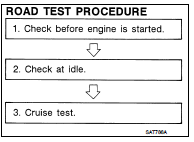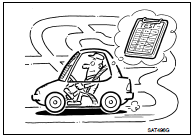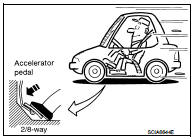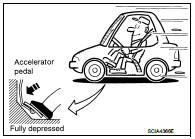Nissan Juke Service and Repair Manual : Road test
Description
DESCRIPTION
• The purpose of the test is to determine overall performance of CVT and analyze causes of problems.
• The road test consists of the following three parts:
1. “Check Before Engine Is Started” TM-190.
2. “Check at Idle” TM-191.
3. “Cruise Test” TM-192.

• Before road test, familiarize yourself with all test procedures and items to check.
• Perform tests on all items until specified symptom is found. Troubleshoot items the malfunctioning items after road test.

CONSULT-III SETTING PROCEDURE
• Using CONSULT-III, perform a cruise test and record the result.
• Print the result and ensure that shifts and lock-ups take place as per Shift Schedule.
1. Touch “DATA MONITOR” on “SELECT DIAG MODE” screen.
2. Touch “MAIN SIGNALS” to set recording condition.
3. See “Numerical Display”, “Barchart Display” or “Line Graph Display”.
4. Touch “START”.
5. When performing cruise test. Refer to TM-192, "Cruise Test".
6. After finishing cruise test part, touch “RECORD”.
7. Touch “STORE”.
8. Touch “BACK”.
9. Touch “DISPLAY”.
10. Touch “PRINT”.
11. Check the monitor data printed out.
Check before Engine Is Started
1.CHECK CVT INDICATOR LAMP
1. Park vehicle on flat surface.
2. Move selector lever to “P” position.
3. Turn ignition switch OFF. Wait at least 5 seconds.
4. Turn ignition switch ON. (Do not start engine.)
Is shift position indicator activated for about 2 seconds? YES >> 1. Turn ignition switch OFF.
2. Perform self-diagnosis and note NG items.
Refer to TM-159, "CONSULT-III Function (TRANSMISSION)".
3. Go to TM-191, "Check at Idle".
NO >> Stop “Road Test”. Refer to TM-259, "Symptom Table".
Check at Idle
1.CHECK STARTING THE ENGINE
1. Park vehicle on flat surface.
2. Move selector lever to “P” or “N” position.
3. Turn ignition switch OFF.
4. Turn ignition switch to “START” position.
Is engine started? YES >> GO TO 2.
NO >> Stop “Road Test”. Refer to TM-259, "Symptom Table".
2.CHECK STARTING THE ENGINE
1. Turn ignition switch ON.
2. Move selector lever to “D”, “M” or “R” position.
3. Turn ignition switch to “START” position.
Is engine started? YES >> Stop “Road Test”. Refer to TM-259, "Symptom Table".
NO >> GO TO 3.
3.CHECK “P” POSITION FUNCTION
1. Move selector lever to “P” position.
2. Turn ignition switch OFF.
3. Release parking brake.
4. Push vehicle forward or backward.
5. Apply parking brake.
Does vehicle move forward or backward? YES >> Refer to TM-259, "Symptom Table". Continue “Road Test”.
NO >> GO TO 4.
4.CHECK “N” POSITION FUNCTION
1. Start engine.
2. Move selector lever to “N” position.
3. Release parking brake.
Does vehicle move forward or backward? YES >> Refer to TM-259, "Symptom Table". Continue “Road Test”.
NO >> GO TO 5.
5.CHECK SHIFT SHOCK
1. Apply foot brake.
2. Move selector lever to “R” position.
Is there large shock when changing from “N” to “R” position? YES >> Refer to TM-259, "Symptom Table". Continue “Road Test”.
NO >> GO TO 6.
6.CHECK “R” POSITION FUNCTION
Release foot brake for several seconds.
Does vehicle creep backward when foot brake is released? YES >> GO TO 7.
NO >> Refer toTM-259, "Symptom Table". Continue “Road Test”.
7.CHECK “D” POSITION FUNCTION
Move selector lever to “D” position and check if vehicle creeps forward.
Does vehicle creep forward in all positions? YES >> Go to TM-192, "Cruise Test".
NO >> Stop “Road Test”. Refer to TM-259, "Symptom Table".
Cruise Test
1.CHECK VEHICLE SPEED WHEN SHIFTING GEARS — PART 1
1. Drive vehicle for approximately 10 minutes to warm engine oil and CVT fluid up to operating temperature.
CVT fluid operating temperature: 50 – 80°C (122 – 176°F)
2. Park vehicle on flat surface.
3. Move selector lever to “P” position.
4. Start engine.
5. Move selector lever to “D” position.
6. Accelerate vehicle to 2/8-way throttle depressing accelerator pedal constantly.
 Read vehicle speed and engine
Read vehicle speed and engine
speed. Refer to TM-308,
"Shift Characteristics".
OK or NG
OK >> GO TO 2.
NG >> Refer to TM-259, "Symptom Table". Continue “Road Test”.

2.CHECK VEHICLE SPEED WHEN SHIFTING GEARS — PART 2
1. Park vehicle on flat surface.
2. Move selector lever to “D” position.
3. Accelerate vehicle to full depression depressing accelerator pedal constantly.
 Read vehicle speed and engine
Read vehicle speed and engine
speed.Refer to TM-308,
"Shift Characteristics".
OK or NG
OK >> GO TO 3.
NG >> Refer to TM-259, "Symptom Table". Continue “Road Test”.

3.CHECK MANUAL MODE FUNCTION
Move to manual mode from “D” position.
Does it switch to manual mode? YES >> GO TO 4.
NO >> Refer to TM-259, "Symptom Table". Continue “Road Test”.
4.CHECK SHIFT-UP FUNCTION
During manual mode driving, is upshift from M1 → M2 → M3 → M4 → M5 → M6
performed?
 Read the gear position. Refer to
Read the gear position. Refer to
TM-159, "CONSULT-III Function (TRANSMISSION)".
Is upshifting correctly performed? YES >> GO TO 5.
NO >> Refer to TM-259, "Symptom Table". Continue “Road Test”.
5.CHECK SHIFT-DOWN FUNCTION
During manual mode driving, is downshift from M6 → M5 → M4 → M3 → M2 → M1
performed?
 Read the gear position. Refer to
Read the gear position. Refer to
TM-159, "CONSULT-III Function (TRANSMISSION)".
Is downshifting correctly performed? YES >> GO TO 6.
NO >> Refer to TM-259, "Symptom Table". Continue “Road Test”.
6.CHECK ENGINE BRAKE FUNCTION
Check engine brake.
Does engine braking effectively reduce speed in M1 position? YES >> 1. Stop the vehicle.
2. Perform self-diagnosis. Refer to TM-159, "CONSULT-III Function (TRANSMISSION)".
NO >> Refer to TM-259, "Symptom Table". Then continue trouble diagnosis.
 Line pressure test
Line pressure test
Inspection and Judgment
INSPECTION
Line Pressure Test Port
Line Pressure Test Procedure
1. Inspect the amount of engine oil and replenish if necessary.
2. Drive the car for about 10 minutes to ...
 CVT position
CVT position
Inspection and Adjustment
INSPECTION
1. Place selector lever in “P” position, and turn ignition switch ON (engine
stop).
2. Make sure that selector lever can be shifted to other than “P” position ...
Other materials:
Models without Intelligent Key system
1. Apply the parking brake.
2. Continuously Variable Transmission (CVT) models:
Move the shift lever to the P (Park) or N (Neutral) position. (P is recommended.)
The starter is designed so that it does not operate unless the shift lever is in
either of the above positions.
Manual Transmission ...
Wiring diagram
Engine control system
For connector terminal arrangements, harness layouts, and alphabets in a
(option abbreviation; if not
described in wiring diagram), refer to GI-12, "Connector Information/Explanation
of Option Abbreviation".
...
U1000 can comm
Description
CAN (Controller Area Network) is a serial communication line for real time
applications. It is an on-vehicle multiplex
communication line with high data communication speed and excellent error
detection ability. Modern
vehicle is equipped with many electronic control unit, and eac ...
